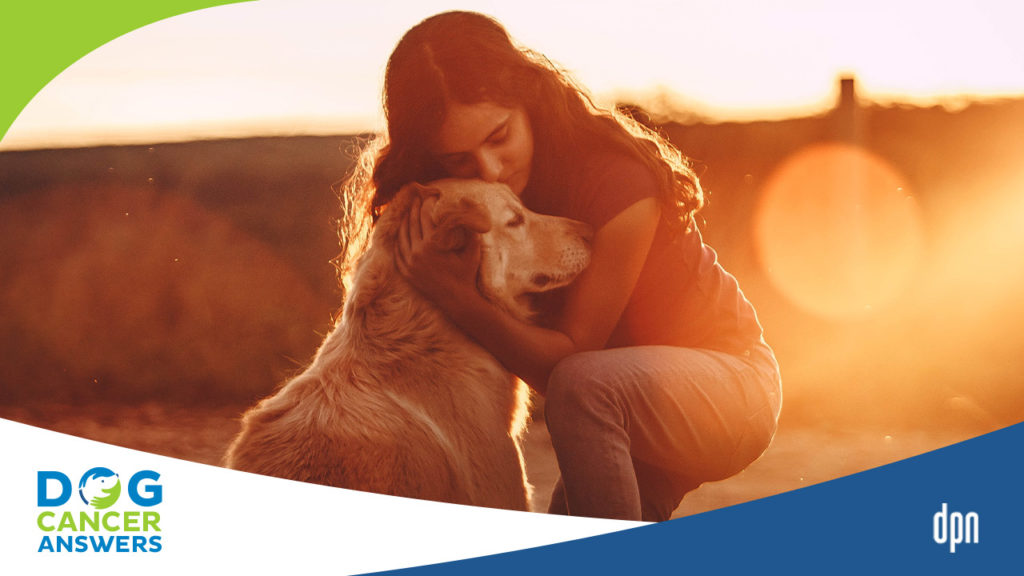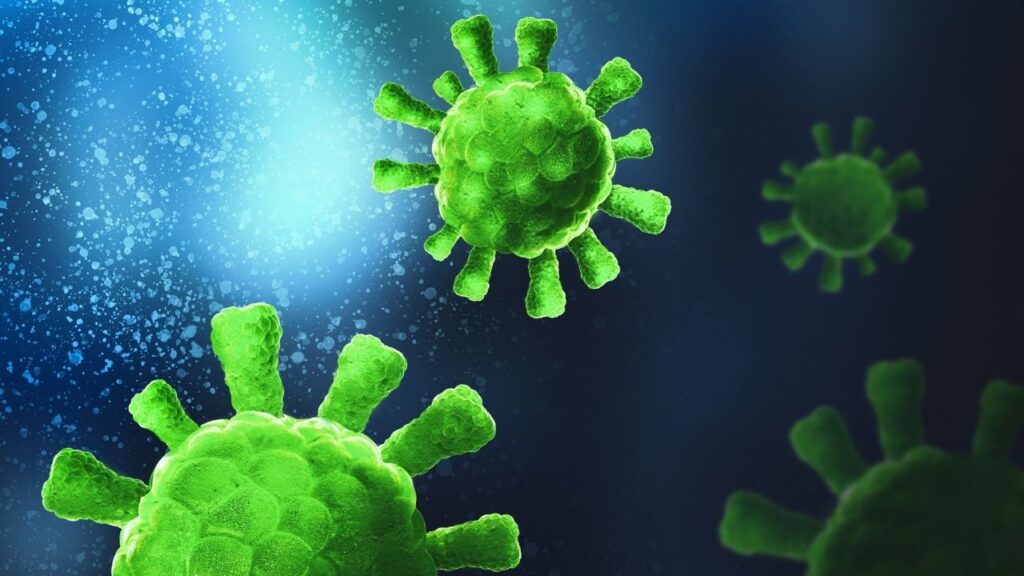Stress can weaken the immune system and shut down important bodily functions. This creates an environment for cancer to develop and thrive. The mind-body relationship is a complex system. Reducing stress in your dog’s life can decrease their risk of cancer and help them combat it.
Key Takeaways
- Prolonged and high levels of stress can weaken your dog’s immune system and cause other important bodily functions to not work as well.
- Signs of stress in a dog may be subtle and could include one or more of the following: trembling, whining, excessive barking, panting, looking away from you, turning their head away, yawning, nose licking, paw lifting, eating feces, and aggressiveness.
- You can relieve your dog’s stress in several ways, primarily by reducing your own levels of stress. Dogs also like routine, mental and physical stimulation, and even meditation.
- Determining what is causing your dog’s stress and eliminating or minimizing it is a good idea.
- Stress in dogs can be triggered by single incidents or ongoing situations your dog has no control over. Elevated and prolonged stress is more dangerous for dogs at the physical and psychological level.
Pay Attention to Stress in Dogs
Many people assume dogs don’t get stressed out, but that’s not true. Prolonged stress in dogs can increase the risk they develop cancer, and reducing stress in dogs may help them fight cancer that has established itself.
The Weird History of Stress
What do you think of when you hear the word “stress?”
A state of being? Constant pressure? The body’s response to something negative?
Stress is used in everyday language. It’s become difficult to define both clinically and in layman’s terms.
Pre-1930’s, the word “stress” was only used to convey a vague feeling of being.1
It wasn’t until 1936 that endocrinologist Dr. Hans Selye first attempted to apply a clinical definition to the word.2
Dr. Selye used rats in his research. The rats were regularly becoming ill and dying before his experiments could produce tangible results.1
Dr. Selye concluded that the rats used in his work were responding to the experiments and the “stress” they inherently caused. This “stress” was making them sick and causing their death.1
An Early Definition of “Stress”
Dr. Selye described “stress” in 1936 as the “nonspecific response of an organism to noxious stimuli.”2
“Stress” soon became a buzzword but its exact definition in the medical world remains hotly debated.
Most run along the lines of, “the response of an organism to an internal or external threat whereby it concentrates its effort to cope with it.”1
In other words, stress is focusing on a threat, either internal or external, to try to deal with it.
Eustress Versus Distress
Dr. Selye separated his clinical definition of stress into eustress and distress.
Eustress
Eustress is a form of positive physiological stress. Eustress is the limited effort an animal makes to adapt to its environment.2
Eustress aligns more with acute stress. This is caused by isolated incidents that may happen several times throughout your dog’s day.
For example, your dog may see another dog and hold a high posture while determining if the other dog is or is not a threat.
During this time, the following happens:
- Your dog’s autonomic nervous system activates
- Stress hormones flood the body
- Their heart rate as well as their blood pressure increases.3
Once they realize the dog is friendly, or one known to them, or they pass that dog, their nervous system regulates the body back to their normal equilibrium.
Distress
Distress is a negative form of stress. Distress is when an animal’s adaptive effort requires so much energy that it becomes detrimental to other important bodily functions.2
Distress aligns more with chronic stress. This is prolonged and driven by external factors that are not resolved.
For example, dogs in a crowded shelter may experience isolation and loud noises for weeks at a time. This constantly induces stress that they have no control over.
That constant stress they have no control over is likely distressing for them.
A Brief Physiology Lesson to Understand Stress in Your Dog
Your dog’s body has two primary stress-responsive systems.4
The Sympathetic Nervous System (SNS)
The SNS is one three components of the autonomic nervous system.
It’s responsible for the body’s “fight or flight” response.
It produces hormones like norepinephrine and epinephrine.4
The Hypothalamic-Pituitary Adrenal Axis (HPA)
The HPA is separate from, but connected to, the autonomic nervous system.
It releases stress hormones that help the body cope with stress.
Frequent or elevated stress hormones can have detrimental consequences to immunity, welfare, and emotions, as well as learning and memory processes.
A Short Guide to Dog Stress Symptoms
Dogs can’t verbally communicate that they are experiencing stress. They have other ways of telling us they are experiencing stress. These are some of the signs that might indicate your dog is under stress:
- Trembling
- Whining
- Excessive barking
- Panting
- Diverting their gaze
- Turning their heads
- Yawning
- Nose licking2
- Paw lifting
- Eating feces
- Aggressiveness (Male beagles that were isolated from their peers displayed more aggressive and dominant behavior when reintroduced to them at a later date.)21
Some of these are critical signs of stress in a dog that may need veterinary attention. The more signs of stress you see, the more likely it is that you need to check in with your veterinarian to help your dog.
The Connection Between the Mind and Body Is Powerful
The connection between psychology and cancer has been of interest since Ancient Greece.8
Medical practitioners in the 18th and 19th centuries postulated that cancer and one’s emotional state were connected.5
Case notes from doctors in 1779 reveal that events leading up to a patient’s cancer diagnosis resulted in perceived connections with “trouble” or “grief.”5 Doctors also made observations that “melancholic” women were more prone to cancer than “happy” or “content” women.5
The significance of these observations wouldn’t start to take hold until the 20th century when psychology, statistics, and physical observations were able to medically link psychological states to cancer.5
A study in the 1940s found that that widowed women had higher cancer mortality than single or married women regardless of genetic predisposition, reproductive status, age, or social class. The study’s author could not determine how this biologically happened.6
The Rising Field of Psychoneuroimmunology
“Psychoneuroimmunology” is the study of the natural connections between brain chemistry, immunology, and physiology.7
In other words, how our mental and emotional states impact our health.7
It’s a field that’s quickly growing. Stress has become one of the most studied psychological factors related to cancer initiation and progression.8 Evidence overall suggests that there is a link between stress and cancer.
How Are Stress and Cancer Connected?
Stress can negatively affect the immune system. The immune system and cancer are closely linked.9
Immune related cells important for fighting cancer such as T-cells and natural killer cells, become less efficient when the body is unbalanced.10
Stress related hormones can promote the growth of abnormal cells. They limit apoptosis, or programmed cell death, and DNA repair systems, while supporting the creation of blood vessels that feed tumor growth and the spread of cancer.10,11,12
A study published in 2004 surveyed 257 women with breast cancer and 565 cancer-free women from Poland.13 Women who had experienced major life events, encountered stress in their daily lives, and exhibited signs of depression had a 3.7 times higher risk of breast cancer. Of these, 89.1% reported that their job was stressful, fretful, or had experienced a major life event while only 71.7% of women without cancer reported that their job was stressful, fretful, or had experienced a major life event.
Similar findings have been reported for men. A study of workplace stress on the risk of 11 different cancer types among 3,103 diagnosed men and 512 healthy men found that employment in at least one stressful job increased the chances of developing lung, colon, bladder, rectal, and stomach cancer.14
Stress is also linked to the growth of tumors once they are established. In a study involving mice with tumors, some were kept confined and isolated, while others were given more freedom of movement and allowed to be with each other. The confined and isolated mice were more likely to experience tumor growth than their counterparts.15
Doing what you can to reduce stress is a good idea for both preventing and treating cancer.
Evidence of the Connection Between Cancer and Stress in Dogs
Two studies applied coal tar, a residue left over from the production of coal gas that’s commonly used in the medical field, to the skin of dogs. Dogs who exhibited signs of stress were more likely to develop malignant tumors at the site of application.16
The author of a 1966 study wrote that neurotic dogs were more frequently diagnosed with malignant tumors than dogs who were categorized as stable.17
Researchers studying a group of 69 healthy dogs and 69 dogs that were diagnosed with cancer found that more dogs in the latter group faced changes in their household and routine prior to their diagnosis.9 In addition, behavioral signs associated with stress were reported more for dogs who were eventually diagnosed with cancer.9
More recent studies involving dogs are lacking but will likely increase as more attention is given to the mind-body relationship.7
Risk Factors for Stress in Dogs
Breed may play a strong role in a dog’s susceptibility to stress.
Over 50 American Kennel Club (AKC) registered dog breeds have family lines with extreme “fear, shyness, nervousness, panic, and anxiety.”18
This could be for two reasons:
- The genes responsible for the body’s adaptability to stress may have been compromised during the artificial selection of desirable traits and features.
- The breed’s intended purpose may have called for personality traits more commonly associated with stress. For example:
- Belgian Malinois were bred to be reactive for the purposes of patrol and detection.
- Labrador retrievers were bred for a calm and steady temperament.18
Dogs who have been diagnosed with one mental neurosis are much more likely to receive additional diagnoses, which further suggests a heritable basis for stress.19
Pre-natal Environment
Even the stress your dog experiences in utero can impact them throughout their lifetime.
Female dogs used by commercial breeders are more likely to have puppies that have neurohormonal dysfunction and dysregulation of the HPA axis.20
Some puppies grow out of these issues within the first year.4
Others continue to display an impaired ability to cope with unpredictable and negative events.20
Sex
A study that tested the stress response of group versus isolated housing on male and female beagles found that unspayed females showed stronger indications of stress than males.21
Previous Cancer Experience
A previous cancer diagnosis may increase the riskiness of stress.
Stress hormones cause the rapid release of proinflammatory proteins by neutrophils. Neutrophils are a type of white blood cell important for immunity.
The release of proinflammatory proteins can ignite pathways in tumor cells that were previously “dormant” post-treatment.22
Higher concentrations of these proinflammatory proteins in the blood of patients who had lung cancer relapsed within a shorter time period.22
How to Help A Stressed Dog
Reducing stress in your dog’s life is important no matter their disease state. Reducing stress decreases your dog’s risk of getting cancer and prevents many other ailments, such as cardiovascular disease.9
If your dog already has cancer, reducing stress is crucial for care.7
Watch for Signs
Know what behaviors are indicative of stress in your dog; it will help you determine what’s causing their stress. Keep an eye out for behaviors that may indicate that your dog is stressed. Do your best to pinpoint the cause and take corrective action.23 This allows you to avoid the number of times your dog’s stress response is triggered.2
Think About Your Dog’s Breed
Due to a likely genetic basis for stress and the behaviors it can cause, knowing your dog’s breed and their typical personality profile can be incredibly insightful.
Here are two examples:
- Basenjis are known to suffer from separation anxiety.23 A busy schedule that keeps you from their company will induce stress, but working from home might be ideal.
- Akitas are known to aggressively guard their territory. Regularly having guests or other dogs in your home can be stressful for them.23
Destress Deliberately
Incorporate activities that physically and mentally stimulate your dog! There are many ways to destress a dog. Activities that physically and mentally stimulate your dog can be great stress busters.23,4
Physical stimulation can “burn off” stress and helps build muscle, which may be faster to deteriorate with cancer.7 It also stimulates the immune system, which needs all the help it can get when your dog has cancer.7
Physical and mental stimulation can also include time spent with peers. Play dates are a good way to reduce loneliness, and therefore stress. Of course, make sure that the dogs your dog plays with are compatible.7
Reduce Pain
Reducing pain is a big way to curb stress levels, as anyone who has suffered chronic pain knows.
Seeking palliative care to relieve pain, or engaging in alternative practices such as massage and touch therapy can reduce inflammation, increase circulation, elevate the immune system, or work towards killing off cancer cells and shrinking tumor sizes.7
Encourage Sleep
Sleep reduces stress and is the peak time when the hormone melatonin is released from the pituitary gland. Melatonin has been linked to both preventing and fighting cancer.24
Stress-Reducing Supplements
You can help supplement your dog’s diet with stress fighting supplements like eleuthero, also called Siberian ginseng (Eluetherococcus senticosus).
Like any supplement, you’ll want to talk to your vet before you start giving it to your dog.7
Build Routine with Fun Surprises
Unpredictability in daily activities can cause large amounts of stress in dogs.
Your dog being able to anticipate “what’s next” can reduce stress even if that “what’s next” is a stressful event itself. Dogs that were given electric shocks in a 1983 study exhibited lower spikes in a stress-related hormone when they had a warning before the shock.25
You’ll want to strike a balance between predictability and unpredictability. For example, you can take your dog every day on a walk at noon for 30 minutes but switch up the route on a daily basis.7
Build Your Bond
Perhaps most important, make sure you build a bond with your dog. A strong bond can result in a secure base that acts as a buffer against stress for our dogs.26
A great bond can also mean that your dog feeds off your energy. If you are highly stressed, your dog knows it.
In a study that combined breath and sweat samples from participants before and after completing a stressful task, dogs were able to alert researchers as to which was the “stressed” sample 90% to 96.88% of the time.27
Take Care of Yourself to Take Care of Stress in Dogs
Reducing your stress levels will reduce your dog’s stress levels. It can be hard to remember to take care of yourself when you’re hyper-focused on helping your dog fight their cancer. One way to refocus is to include your dog in activities that help lower stress, such as meditation.28 And as always, we recommend seeking therapy and support; it really does help.
- Rothman L. Meet the Doctor Who Changed Our Understanding of Stress. Time Magazine. March 10, 2016. https://time.com/4243311/hans-selye-stress/. Accessed December 29, 2022.
- Mariti C, Gazzano A, Moore JL, Baragli P, Chelli L, Sighieri C. Perception of dogs’ stress by their owners. J Vet Beh 2012:7(4):213-219.
- Scott E. All About Acute Stress What You Should Know About Acute Stress. Very well mind. March 19, 2021. https://www.verywellmind.com/all-about-acute-stress-3145064. Accessed on January 19, 2023.
- Dendoncker PA. On the origin of puppies: a multidisciplinary investigation into Belgian dog breeding facilities [Doctoral Dissertation]. Ghent, Belgium: Ghent University; 2019.
- LeShan S. Psychological states as factors in the development of malignant disease: a critical review. J of the National Cancer Institute. 1959;22(1):1-18.
- Peller S. Cancer and its relations to pregnancy, to delivery, and to marital and social status; cancer of the breast and genital organs. Surg Gynec Obst 1940;71:181-186.
- Dressler D, Ettinger S. The Dog Cancer Survival Guide. Maui Media; 2011.
- Lutgendorf SK, Sood AK. Biobehavioral factors and cancer progression: physiological pathways and mechanisms. Psychosom Med 2011;73:724-730.
- Cannas S, Berteselli GV, Piotti P, et al. Stress and cancer in dogs: comparison between a population of dogs diagnosed with cancer and a control population – a pilot study. Mac Vet Rev 2016;39(2):201-208.
- Dunn GP, Old LJ, Schreiber RD. The immunobiology of cancer immunosurveilance and immunoediting. Immunity 2004;21:137-148.
- Thaker PH, Sood AK. Neuroendocrine influences on cancer biology. Semin Cancer Biol 200;18(3):164-170.
- Antoni MH, Lechner S, Diaz A, et al. Cognitive behavioral stress management effects on psychosocial and physiological adaptation in women undergoing treatment for breast cancer. Brain Behav Immun 2009 Jul 1;23(5):580-91.
- Kruk J, Aboul-Enein HY. Psychological stress and the risk of breast cancer: a case-control study. Cancer Detect Prevent 2004;28(6):399-408.
- Blanc-Lapierre A, Rousseau MC, Weiss D, El-Zein M, Siemiatycki J, Parent MÉ. Lifetime report of perceived stress at work and cancer among men: A case-control study in Montreal, Canada. Prev Med. 2017;96:28-35. doi:10.1016/j.ypmed.2016.12.004.
- Moreno-Smith M, Lutgendorf SK, Sood AK. Impact of stress on cancer metastasis. Future Oncol. 2010;6(12):1863-1881. doi:10.2217/fon.10.142.
- Sohl PA. Psychogenic factors in the etiology of cancer. Smith College Studies in Social Work. 1975;155(2):109-136.
- Corson SA. Neuroendocrine and behavioral response patterns to psychogenic fat mobilization. An N Y Acad Sci 1966;125(3):924-927.
- Overall KL, Dunham AE. A protocol for predicting performance in military working dogs: roles for anxiety assessment and genetic markers. International Workings Dogs Association 2005.
- Overall KL. Dogs as “natural” models of human psychiatric disorders: assessing validity and understanding mechanism. Prog Neuropsychopharmacol Biol Psychiatry 2000; 24:727-276.
- McMillan F, Duffy DL, Serpell JA. Mental Health of Dogs Formerly Used as ‘Breeding Stock’ in Commercial Breeding Establishments. App Anim Behav Sci 2011;135(1-2):86-94.
- Beerda B, Schilder MBH, Bernadina W, Van Hooff JARAM, De Vries HW, Mol JA. Chronic stress in dogs subjected to social and spatial restriction. II. Hormonal and Immunological Responses. Phys Behav 1999;66(2):243-254.
- Perego M, Tyurin VA, Tyurina YY, et al. Reactivation of dormant tumor cells by modified lipids derived from stress-activated neutrophils. Sci Transl Med. 2020;12(572):eabb5817. doi:10.1126/scitranslmed.abb5817.
- Wójcik A, Powierza K. The influence of breed, sex, origin and housing conditions on undesirable behaviors in ancient dog breeds. Animals 2021:11:1435.
- Lopes JR, Maschio LB, Jardim-Perassi BV, et al. Evaluation of melatonin treatment in primary culture of canine mammary tumors. Oncol Rep. 2015;33(1):311-319. doi:10.3892/or.2014.3596.
- Dess-Beech N, Linwich D, Patterson J, Overmier J. Immediate and proactive effects of controllability and predictability on plasma cortisol responses to shocks in dogs. Behav Neurosci 1983:97:1005-1013.
- Horn L, Huber L, Range F. The Importance of the Secure Base Effect for Domestic Dogs – Evidence from a Manipulative Problem-Solving Task. PLoS One 2013;8:e65296.
- Wilson C, Campbell K, Petzel Z, Reeve C. Dogs can discriminate between human baseline and psychological stress conditions odours. PLoS ONE. 2022:17(9);e0274143.
- Jacobson J, Chandler-Madera K. How to Meditate with Your Dog: An Introduction to Meditation for Dog Lovers. Maui Media; 2005.
Topics
Did You Find This Helpful? Share It with Your Pack!
Use the buttons to share what you learned on social media, download a PDF, print this out, or email it to your veterinarian.






